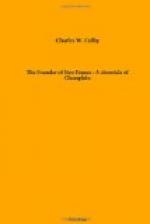Among the many writings which are available for comparison and contrast one turns, singularly yet inevitably, to Lescarbot. The singularity of a comparison between Champlain and Lescarbot is that Lescarbot was not a geographer. At the same time, he is the only writer of importance whose trail crosses that of Champlain, and some light is thrown on Champlain’s personality by a juxtaposition of texts. That is to say, both were in Acadia at the same time, sat together at Poutrincourt’s table, gazed on the same forests and clearings, met the same Indians, and had a like opportunity of considering the colonial problems which were thrust upon the French in the reign of Henry iv.
It would be hard to find narratives more dissimilar,—and the contrast is not wholly to the advantage of Champlain. Or rather, there are times when his Doric simplicity of style seems jejune beside the flowing periods and picturesque details of Lescarbot. No better illustration of this difference in style, arising from fundamental difference in temperament, can be found than the description which each gives of the Ordre de Bon Temps. To Champlain belongs the credit of inventing this pleasant means of promoting health and banishing ennui, but all he tells of it is this: ’By the rules of the Order a chain was put, with some little ceremony, on the neck of one of our company, commissioning him for the day to go a-hunting. The next day it was conferred upon another, and thus in succession. All exerted themselves to the utmost to see who would do the best and bring home the finest game. We found this a very good arrangement, as did also the savages who were with us.’
Such is the limit of the information which we receive from Champlain regarding the Ordre de Bon Temps, his own invention and the life of the company. It is reserved for Lescarbot to give us the picture which no one can forget—the Atoctegic, or ruler of the feast, leading the procession to dinner ’napkin on shoulder, wand of office in hand, and around his neck the collar of the Order, which was worth more than four crowns; after him all the members of the Order, carrying each a dish.’ Around stand the savages, twenty or thirty of them, ’men, women, girls, and children,’ all waiting for scraps of food. At the table with the French themselves sits the Sagamos Membertou and the other Indian chiefs, gladdening the company by their presence. And the food!—’ducks, bustards, grey and white geese, partridges, larks, and other birds; moreover moose, caribou, beaver, otter, bear, rabbits, wild-cats, racoons, and other animals,’ the whole culminating in the tenderness of moose meat and the delicacy of beaver’s tail. Such are the items which Champlain omits and Lescarbot includes. So it is throughout their respective narratives—Champlain ever gaining force through compactness, and Lescarbot constantly illuminating with his gaiety or shrewdness matters which but for him would never have reached us.




